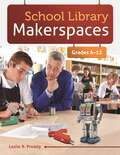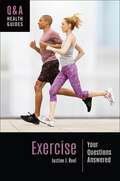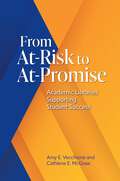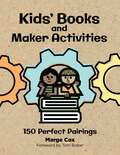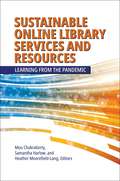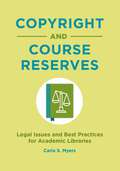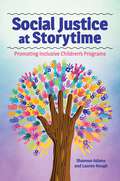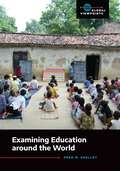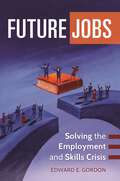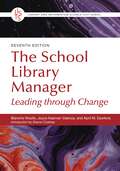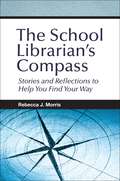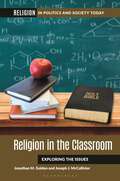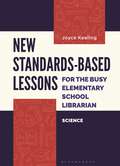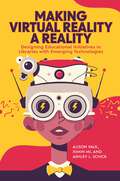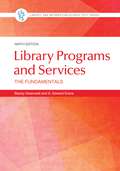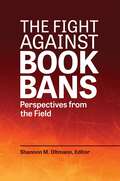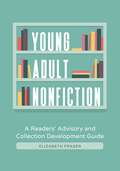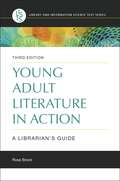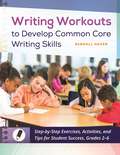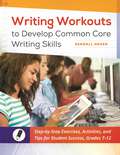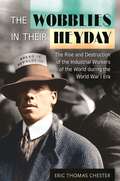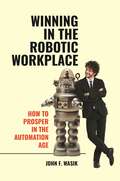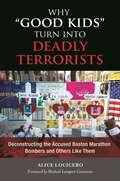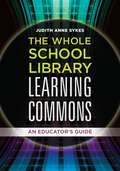- Table View
- List View
How the West Indian Child is made Educationally Subnormal in the British School System: The scandal of the Black Child in Schools in Britain
by Bernard Coard"In the book, Coard examines educational inequality and institutional racism in the British educational system through the lens of the country's "educationally subnormal" (ESN) schools—previously called "schools for the mentally subnormal"—which disproportionately and wrongly enrolled Black children, especially those from the British Afro-Caribbean community." -Wikipedia
School Library Makerspaces: Grades 6–12
by Leslie B. PreddyAn essential resource for intermediate, middle, and high school librarians that guides the planning, learning, and implementation of a school library makerspace.The roles of school library media specialists and school libraries themselves are ever changing in response to the needs of the community and the evolution of human thinking, interaction, and learning processes. A school library makerspace can provide patrons with a place for learning, doing, and creating. It offers a location for tackling inventions, fine arts, crafts, industrial technology, hobbies, e-textiles, foodcrafting, DIY couture, fabrication, upcycling, and STEM right in the middle of the information gateway—the library. This book completely explains the makerspace concept and supplies real-world implementation guidance and inexpensive programming ideas that can be used as-is or adapted to suit a specific library or community's needs. Readers will be able to hit the ground running to implement their own makerspace with practical project ideas they can put to use immediately.
Exercise: Your Questions Answered (Q&A Health Guides)
by Justine J. ReelThis book answers readers' most pressing questions about exercise and physical activity and will serve as a valuable resource to anyone interested in starting and maintaining healthy habits in this important area of health.Whether it's going for a run or to a yoga class, playing basketball with friends, or spending an afternoon doing yardwork, moving our bodies regularly is vital for both our physical and mental well-being. This book explores the different forms of exercise and physical activity, their benefits and risks, why so many people find it difficult to be physically active, and how to create and maintain a healthy, sustainable plan for physical activity.Books in Greenwood's Q&A Health Guides series follow a reader-friendly question-and-answer format that anticipates readers' needs and concerns. Prevalent myths and misconceptions are identified and dispelled, and a collection of case studies illustrates key concepts and issues through relatable stories and insightful recommendations. Each book also includes a section on health literacy, equipping teens and young adults with practical tools and strategies for finding, evaluating, and using credible sources of health information both on and off the internet—important skills that contribute to a lifetime of healthy decision-making.
From At-Risk to At-Promise: Academic Libraries Supporting Student Success
by Amy E. Vecchione Cathlene E. McGrawAcademic library workers will learn how to collaborate with staff in academic advising and student services to improve undergraduate student belonging, retention rates, and graduation rates for at-promise students.As the demographics of student populations change, many students require additional or different support to be successful in their college careers. Meanwhile, higher education is under pressure to reduce budgets and serve more students within certain areas of the university, including the library, academic advising, and other student services. Academic librarians and student success administrators can collaborate to create additional pathways for students who struggle to succeed.Authors Vecchione and McGraw provide a roadmap for library employees and student success administrators to initiate and develop discussions on college campuses to define and address these emergent student needs. Through a selection of case studies and historical context, readers will learn how to define what student success looks like and how to design custom services to address student barriers to that success. Library employees and student success professionals both serve students at the margins. These readers will acquire skills to enhance student success initiatives and strengthen collaborations with one another.
Kids' Books and Maker Activities: 150 Perfect Pairings
by Marge CoxThis book connects to the new AASL standards, ISTE Standards for Students, and provides simple directions for using a variety of books to create maker activities that deepen the reading experience.Books and maker activities help children to associate reading with hands-on learning. For educators looking for additional ways to engage youngsters in reading and maker activities, this book provides the perfect hands-on connection.Providing connections to the new AASL standards and the ISTE Standards for Students with simple directions for using a variety of books to create maker activities, this book can help elementary teachers and librarians to enhance and deepen the reading experience. Featured books represent a variety of genres for kindergarten through sixth-grade students and highlights very current titles as well as classics.The book is based on actual experiences with students and staff who have enjoyed and benefited from these activities in their elementary school library. The author's forty years of educational experience ensure the reliability and practicality of this resource that readers can trust and use every day.
Sustainable Online Library Services and Resources: Learning from the Pandemic
by Mou Chakraborty, Samantha Harlow, and Heather Moorefield-LangCOVID-19 shifted library services and resources; this book includes narratives of lessons learned and sustainable practices to prepare educators and librarians for any challenges that might arise in the future.All different types of libraries (academic, public, special, and school) were impacted by the pandemic, and librarians learned valuable lessons about how to shift and transition in a challenging time.In this informative book, librarians, instructional designers, educators, and faculty from all over the world write about how they pivoted services and resources online to continue to serve patrons during a pandemic and beyond, as well as which services and programs will be sustainable and scalable. Online delivery of programs and services allows librarians to respond to many different situations, emergencies, and challenges, and this book is a record of the lessons that librarians learned and the practices they'll implement in the future based on their experiences with COVID-19. Sustainable Online Library Services and Resources showcases a diverse range of perspectives on how online learning has changed and grown with a focus on what library services and resources are here to stay.
Copyright and Course Reserves: Legal Issues and Best Practices for Academic Libraries
by Carla S. MyersWith the guidance of this book, academic librarians wishing to provide print, electronic, and streaming media (music and film) course reserve services for their campus communities can do so in compliance with U.S. copyright law.Many academic libraries offer print and electronic course reserve services that encourage learning by connecting students and faculty with less expensive and supplementary educational materials. Unfortunately, there are many misconceptions regarding how U.S. copyright law affects course reserve services; as a result, many academic libraries restrict the scope of the services they provide or refrain from pursuing new options, such as media reserves, out of fear of violating the law or being sued for copyright infringement. Copyright and Course Reserves addresses this problem, providing authoritative advice for making print, electronic, and media course reserves available in compliance with U.S. copyright law. It explains options for implementing and sustaining media reserve services through which students and faculty can access online music, sound recordings, and film. Additionally, short examples from a wide range of libraries explore real-world scenarios and current issues related to course reserve services to help readers better understand and apply the information found in the book.
Social Justice at Storytime: Promoting Inclusive Children's Programs
by Shannon Adams Lauren HoughYouth librarians and early literacy educators will find this book a helpful tool for making storytimes more inclusive and better representative of their community and the world at large.Written by two experienced librarians from one of the nation's most diverse metroplexes, Social Justice at Storytime provides a real-world, hands-on guide to storytimes that will help young people become more socially aware, empathetic, and confident. Storytimes can be a welcoming space for all members of the community. Anyone presenting storytime to young children can use these suggestions to broaden children's understanding of the often-confusing situations they see and hear around them. It is possible to discuss race, gender/sexuality, and diverse abilities in a child-appropriate way. Making social justice a part of an existing or new storytime practice provides an early literacy approach to including children in timely conversations.Readers of this thoughtful book will not only become more socially aware and empathetic, but they will also be equipped to choose diverse books and songs, make thoughtful and inclusive language choices, become more in tune with their diverse communities, and handle concerns from caregivers or administrators.
Examining Education around the World (Global Viewpoints)
by Fred M. ShelleyThis thematic encyclopedia provides an overview of education as undertaken in the United States and in 70 countries worldwide and links educational organization, philosophy, and practice with important global social, economic, and environmental issues facing the contemporary world.All around the world, young people attend school, be it in the steppes of Mongolia, the tiny island nations of the Pacific, or the urban centers of Mexico. How do countries meet the educational needs of their citizens?This volume is organized into 10 chapters that look at key issues in global education, including literacy, gender, religion, science and technology (STEM), arts and humanities, school violence, multicultural education and diversity, environment and sustainability, education and difference/special needs, and views on education and a country's future. Each chapter contains eight country profiles, one for the United States and one each for seven other countries. Each entry includes a brief overview of the country and its history and geography, a description of its K–12 education system, and more detailed information about that country with respect to the appropriate topic. This book allows readers to compare and contrast education throughout the world. It also analyzes, from both contemporary and historical perspectives, relationships between education and the ways in which different countries address various issues, including development, diversity, gender, and environmental sustainability.
Future Jobs: Solving the Employment and Skills Crisis
by Edward E. GordonA pervasive disconnect exists between the job/career culture and the present economic reality in America. This book offers powerful strategies for stemming the employment crisis and proposes comprehensive solutions for businesses, government, and job seekers alike.America's low unemployment rate overshadows the fact that more that 20 million Americans are still unemployed. Moreover, more than eight million jobs are vacant because employers cannot find qualified candidates. It is projected that if this imbalance between available positions and skills is not quickly addressed, more than 14 million jobs will be vacant by 2020, and that many more people out of work.In Future Jobs, historical economist Edward E. Gordon explains how increasingly complex technologies, global demographic shifts, and outdated education-to-employment systems are converging and may imminently cause a labor-market crisis. How can we ensure that enough people possess the skills necessary to holding the jobs of today and tomorrow? This book points to a solution gaining traction across the United States: Regional Talent Innovation Networks (RETAINs), alliances of businesses, educators, government agencies, and nonprofit organizations that successfully bridge the talent gap. Additionally, it provides information on the most promising jobs and careers of the next decade for early-career job seekers and for workers who are looking to change career paths.
The School Library Manager: Leading through Change (Library and Information Science Text Series)
by Blanche Woolls Joyce Kasman Valenza April M. DawkinsThe seventh edition of this comprehensive school library management text expands upon the role of the school librarian, especially in the ever-growing digital realm, and highlights the importance of school librarian leadership and outreach.In an era of budget cuts, reduced staffing, and a global pandemic, it's more important than ever for new LIS professionals and established school librarians and administrators to demonstrate the value of school libraries to decision makers.This revised and updated edition of a classic text adds two well-known authors to help lead readers through the many essential management tasks and skills required to administer the successful school library program. It emphasizes the importance of the school librarian in providing digital access to information for teachers and students, describes how facilities are being modified to accommodate new resources and programming, and offers new ways to use AASL standards to evaluate programs.All chapters are updated, and the text addresses such timely subjects as providing information resources when students, teachers, and librarians are interacting online. A new chapter highlights the importance of the school librarian's leadership in schools, districts, and communities. This invaluable textbook teaches practical skills for school library management and offers inspiration and guidance for growing LIS careers.
The School Librarian's Compass: Stories and Reflections to Help You Find Your Way
by Rebecca J. MorrisBy working through these cases and the accompanying learning exercises, both pre-service and practicing school librarians will strengthen their readiness, expand their perspectives, and build confidence for solving problems and making informed, thoughtful decisions in their school libraries.In their preparation for school librarianship, library students learn foundational ideals and observe best practices that center and guide their work. However, discussions of aspirational versions of school librarianship often leave out sufficient practice in managing the many challenges and decisions school librarians face on the job. In this book, veteran educator Rebecca J. Morris uses stories of day-to-day librarianship to empower school librarians as they navigate and manage the complex interactions, decisions, and opportunities of their work.The book's alignment with the AASL/CAEP standards makes it helpful to school library educators planning curriculum, syllabi, and course activities. Perfect for reading or study groups, graduate classes, and professional development, these stories invite reflection and lively conversation.
Religion in the Classroom: Exploring the Issues (Religion in Politics and Society Today)
by Jonathan M. Golden Joseph J. McCallisterAn indispensable resource for understanding religion's place in American schools and in matters concerning the separation of church and state in the United States.The framers of the American Constitution, in drafting the so-called "Establishment Clause" of the First Amendment-Congress shall not establish nor prohibit the practice of religion-intentionally juxtaposed two seemingly contrasting articles, understanding that we would grapple with these questions anew each day. And, indeed, we have. This book treats the Constitution, and the First Amendment in particular, as a living document, one that requires interpretation and re-interpretation on a regular basis as our nation and its people evolve. The book begins with an overview essay discussing the background of the contemporary debate over religion in schools. A timeline then highlights key events related to religion and education. Approximately 50 alphabetically arranged reference entries follow. These focus on contemporary concerns and provide objective, fundamental information about events, legislation, people, and other topics. The entries provide cross-references and suggestions for further reading, and the volume closes with an annotated bibliography.
New Standards-Based Lessons for the Busy Elementary School Librarian: Science
by Joyce KeelingThis book provides targeted and invaluable help for the busy elementary school librarian and the science teacher as they work together to design and co-teach library-based lessons guided by the Next Generation Science Standards, English Literacy Common Core Standards, and the new AASL Standards.All standards are cited in easy-to-use reproducible lessons. Energy-packed and interactive lessons are coordinated to common elementary science curricula at the grade level indicated and are also adaptable and usable as template lessons as needed. Necessary handouts and other tools, with current lists of recommended resources, are provided.Elementary school librarians and classroom teachers as well as curriculum coordinators, elementary reading, social studies, and science instructors will find value in this collection of lessons. The highly rated materials recommended in the resource lists are valuable for aiding librarians in collection development to support new and current standards.
Making Virtual Reality a Reality: Designing Educational Initiatives in Libraries with Emerging Technologies
by Alison Valk Ximin Mi Ashley L. SchickWalks readers through the key components of developing library-led research and programming that leverages emerging technologies with the goal of engaging students and faculty.As educational curricula and research evolve to include advanced technologies, libraries must offer programming with these emerging technologies in mind, including the use of virtual reality (VR) and augmented reality (AR). In this timely guide, Valk, Mi, and Schick present readers with tools for assessing their level of organizational readiness to begin such programs and, more importantly, how to sustain them with limited budgets, expertise, and resources.Building on their own experiences, the authors teach readers how to develop technology-rich classes, assess student projects, and overcome technical hurdles. They spotlight this kind of programming as integral to building strategic partnerships in an educational environment. Readers will learn how to adapt and design programs or initiatives in which the necessary technologies are rapidly changing, not only in higher education institutions, but also in schools. Worksheets and resources assist readers in reflecting on their own work and developing educational programming to suit their organizational needs.
Library Programs and Services: The Fundamentals (Library and Information Science Text Series)
by Stacey Greenwell G. Edward EvansThe ninth edition of this popular overview of the various programs and services offered by libraries offers best practice and useful tips for implementing them effectively.Building on the strong foundation of the previous editions, award-winning author G. Edward Evans returns with a new co-author, Stacey Greenwell, for this update that combines their signature style of textbook readability, informality, and sometimes humor, as well as their knack for balancing foundational topics and new trends.A new feature in this edition is the incorporation of the concept of "library social work" through "Social Work Connections" sidebars in each chapter. Anecdotes throughout the text and "Career Connections" sidebars offer practical advice and specific current examples. Greenwell and Evans have combined several chapters from the previous edition and expanded discussions of new trends while retaining and updating the fundamentals. The ninth edition is a welcome update for library and information science courses and a valuable handbook for public services librarians.
The Fight against Book Bans: Perspectives from the Field
by Shannon M. OltmannBook bans and challenges frequently make the news, but when the reporting ends, how do we put them in context? The Fight against Book Bans captures the views of dozens of librarians and library science professors regarding the recent flood of book challenges across the United States, gathered in a comprehensive analysis of their impact and significance. It also serves as a guide to responding to challenges.Chapter authors provide first-hand accounts of facing book challenges and describe how they have prepared for challenges, overcome opposition to certain books, and shown the value of specific library materials. Library science faculty with a range of specialties provide relevant background information to bolster these on-the-ground views. Together, the chapters both articulate the importance of intellectual freedom and demonstrate how to convey that significance to others in the community with passion and wisdom. This volume provides a timely and thorough overview of the complex issues surrounding the ongoing spate of book challenges faced by public and school libraries.
Young Adult Nonfiction: A Readers' Advisory and Collection Development Guide
by Elizabeth FraserCovering more than 500 titles, both classics and newer publications, this book describes what titles are about and why teens would want to read them.Nonfiction has been the workhorse of many young adult library collections—filling information and curricular needs—and it is also the preferred genre for many teen readers. But not all nonfiction is created equal. This guide identifies some of the best, most engaging, and authoritative nonfiction reads for teens and organizes them according to popular reading interests. With genres ranging from adventure and sports to memoirs, how-to guides and social justice, there is something for every reader here.Similar fiction titles are noted to help you make connections for readers, and "best bets" for each chapter are noted. Notations in annotations indicate award-winning titles, graphic nonfiction, and reading level. Keywords that appear in the annotations and in detailed indexes enhance access. Librarians who work with and purchase materials for teens, including YA librarians at public libraries, acquisitions and book/materials selectors at public libraries, and middle and high school librarians will find this book invaluable.
Young Adult Literature in Action: A Librarian's Guide (Library and Information Science Text Series)
by Rose BrockTaking a genre approach, this overview of young adult literature shows new librarians and library science students the criteria to use for selecting quality books, including recommended titles.This third edition of Young Adult Literature in Action draws on the success of the previous two editions authored by Rosemary Chance, updating and expanding on them to meet the needs of today's librarians and library science students. It includes a new focus on diverse books, LGBTQ+ selections, the role of book formats, and the relevance of librarians serving teen populations and is an ideal resource for teaching young adult literature courses.Organized by major genre divisions, this easy-to-use book includes new information on timely topics such as audio and e-books, accessible books, and graphic novels. Each chapter includes revised and updated information on collaborative activities, featured books, special topics and programs, selected awards and celebrations, historical connections, recommended resources, issues for discussion, author comments, and assignment suggestions. Further updates include citations of exemplary young adult books and award winners, references, websites, and a bibliography.
Writing Workouts to Develop Common Core Writing Skills: Step-by-Step Exercises, Activities, and Tips for Student Success, Grades 2–6
by Kendall HavenThis book is a "best of" collection of tips and exercises to help nurture young writers and strengthen core skills. Since each activity has been tried and tested in thousands of classrooms, you'll find successful methods for turning even the most reluctant students into effective, powerful writers.Writing proficiency is more important than ever, especially with the demands of standardized testing and the rigors of new standards impacting our schools. This classroom-tested manual, created from a combination of the author's extensive in-class experience and acclaimed research in neural science and developmental biology, addresses all facets of writing competency. The content links to common core curriculum elements in state language arts standards for every state.Written by experienced educator and author Kendall Haven, the work features 13 innovative writing tips and 30 engaging activities for helping students become better writers. The first part of the book covers writing hints and techniques, while the second half contains core content activities for coaxing the best writing out of your students. A short introductory section lays out the five steps of effective student writing. Lastly, the text reveals how teachers—even those from non-literary backgrounds—can successfully teach and grade writing.
Writing Workouts to Develop Common Core Writing Skills: Step-by-Step Exercises, Activities, and Tips for Student Success, Grades 7–12
by Kendall HavenThis book is a "best of" collection of tips and exercises to help nurture young writers and strengthen core skills. Since each activity has been tried and tested in thousands of classrooms, you'll find successful methods for turning even the most reluctant students into effective, powerful writers.Writing proficiency is more important than ever, especially with the demands of standardized testing and the rigors of new standards impacting our schools. This classroom-tested manual, created from a combination of the author's extensive in-class experience and acclaimed research in neural science and developmental biology, addresses all facets of writing competency. The content links to common core curriculum elements in state language arts standards for every state.Written by experienced educator and author Kendall Haven, the work features 13 innovative writing tips and 30 engaging activities for helping students become better writers. The first part of the book covers writing hints and techniques, while the second half contains core content activities for coaxing the best writing out of your students. A short introductory section lays out the five steps of effective student writing. Lastly, the text reveals how teachers—even those from non-literary backgrounds—can successfully teach and grade writing.
The Wobblies in Their Heyday: The Rise and Destruction of the Industrial Workers of the World during the World War I Era
by Eric Thomas ChesterDuring World War I, the Industrial Workers of the World (IWW) rose to prominence as an effective, militant union and then was destroyed by a devastating campaign of repression launched by the federal government. This book documents the rise and fall of this important industrial labor organization.The Industrial Workers of the World—or "Wobblies," as they were known—included legendary figures from U.S. labor history. Joe Hill, "Big Bill" Haywood, and Elizabeth Gurley Flynn have become a part of American popular folklore. In this book, author Eric T. Chester shows just how dynamic a force the IWW was during its heyday during World War I, and how determined the federal government was to crush this union—a campaign of repression that remains unique in U.S. history. This work utilizes a wide array of archival sources, many of them never used before, thereby giving readers a clearer view and better understanding of what actually happened.The book leads with an examination of the three key events in the history of the IWW: the Wheatfield, CA, confrontation; the Bisbee, AZ, deportation; and the strike of copper miners in Butte, MT. The second part of the book deconstructs the IWW's responses to World War I, the coordinated attack by the federal government upon the union, and how the union unraveled under this attack.
Winning in the Robotic Workplace: How to Prosper in the Automation Age
by John F. WasikThis book will examine the history of robotics and explicate what massive automation means for the present and future of labor in all its forms, from mills and factories to the white-collars offices of suburbia and more.While warnings of a robot world-takeover could seem dramatic, the truth is more mundane—robots have come to take our jobs. Winning in the Robotic Workplace: How to Prosper in the Automation Age will teach you the skills needed to reprogram the way you work in anticipation of this technological shift. Author John F. Wasik believes learning to thrive in the automation age can in fact humanize the workplace once again. In Winning in the Robotic Workplace: How to Prosper in the Automation Age, you will learn to emphasize the conceptualization and pursuit of creative ideas, a practice that most robots are unequipped to perform in a meaningful way. You will learn that the successful integration of automated elements with humans is the most effective business model moving forward, and that an eagerness to collaborate demonstrates a will to succeed.
Why "Good Kids" Turn into Deadly Terrorists: Deconstructing the Accused Boston Marathon Bombers and Others Like Them
by Alice LoCiceroUsing psychological theory and the author's direct experience working with at-risk youth, this book answers the questions on the minds of anyone shocked and appalled by the events of the Boston Marathon bombings.The shock of the 2013 Boston Marathon bombings was soon followed by a revelation initially disturbing and mystifying: two apparently unremarkable brothers—one a teenager, the other a young adult; both well-liked immigrants and longtime U.S. residents—had allegedly triggered the bombs. Why were these two seemingly "normal" individuals driven to commit such acts of coldblooded violence? This book examines not only the lives, motivations, and key influences of these infamous brothers, but those of other young, unexpected terrorists worldwide, comparing factors that contributed to their decisions to become terrorists and identifying methods used to recruit them into that deadly fold. The chapters teach readers warning signs that youths are being drawn in to terrorism and serve to spur meaningful conversations among citizens, politicians, and policymakers about what we can do to prevent such recruitment of youths and young adults, including other U.S. residents who might consider emulating the Tsarnaev brothers. The book also addresses larger, related questions, such as whether humans are naturally violent, who benefits when young individuals engage in terrorism, and why minors are recruited to become killers.
The Whole School Library Learning Commons: An Educator's Guide
by Judith Anne SykesIntroduce your teachers, librarians, and administrators to the roles and responsibilities of educators in advocating a whole school library learning commons using this step-by-step guide for creating shared learning space in your school.It is no surprise that technology has shifted the way we educate—bearing on how, what, and where we learn. This guide lays the framework for helping turn your school library into a whole school library learning commons (WSLLC)—a space where traditional academics merge with the latest technologies to engage learners in a way never before realized. Author Judith Anne Sykes contends that since the WSLLC philosophy allows staff and students to co-create knowledge in a shared space, it is more effective than the traditional approach. Sykes addresses the differences between a school library and a WSLLC, provides reasons to champion its creation in your institution, and discusses how to use mentoring as a means to sustain its survival. The book explores the roles and responsibilities of educators in developing WSLLC goals and presents strategies for using typical assessment tools—including standardized tests, report cards, and anecdotal assessments—to help support its philosophy.

